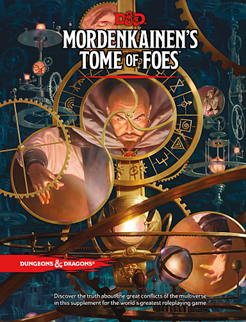Two major groups of foes that have been in Dungeons & Dragons since the very early days are Devils and Demons, beloved by Dungeon Masters because they provide actual danger for high-level characters that many, more mundane, foes do not.
In the original version of D&D, only demons appeared. Why was that? Well, it has a lot to do with the original form of alignment, which only allowed three states: Law, Chaos or Neutral. “Chaos” was considered Evil, for the most part.
However, it wasn’t long before Gygax adopted a nine-point alignment scale, and so Evil actually gained a definition and was further subdivided into Lawful Evil, Chaotic Evil and Neutral Evil. While it took a little time to flesh out what might be in Neutral Evil, the split between Lawful and Chaotic Evil turned out to be Devils and Demons.
The trouble now was deciding what those two types of fiends did. (Not that “fiend” meant anything back then; it’s a more recent term).
If you go through the history of how demons and devils got used in the game, you’ll probably find that there’s a lot of confusion about the distinction between the two. “Law” and “Chaos” turn out to be less useful than you’d expect. The idea of devils as the ones that offer contracts for people’s souls – that was easy to come to, but it didn’t fit how most of the devils worked (who often were little but foot soldiers), nor gave much of an idea about demons. The Monster Manual stated that demons didn’t like serving anyone and the stronger ruled the weaker. Meanwhile, devils had a definite chain of command, which they didn’t break for fear of the archdevils, but they were always squabbling for power. Sounds a lot like demons! But devils, at least, would serve mortals – but such was a risky business, as they were prone to only do so in exchange for the soul of the mortal!
A lot of the early foes in the game tended to be demons (or demon-born). Iuz, Grazzt, Orcus and Zuggtmoy made a lot of appearances in the early adventures (and in Gygax’s Gord the Rogue novels), but it wasn’t always clear what their goals were. Iuz, the half-demon ruler of a nation in the World of Greyhawk, was the hardest to pin down. How do you rule whilst being Chaotic Evil? Both forms of evil tend towards the strongest leading.
One of the more interesting takes on how to deal with demons was casting them as forces of destruction, something that saw a lot of currency during the 4e years. Basically, devils wanted to rule (and didn’t care what they did to get there), while demons wanted to destroy everything! Which, again, is a nice idea and creates some great confrontations in adventures but works against the idea of these Demon Princes ruling layers of the Abyss as they’re not destroying everything. They’re ruling! And what about Iuz?
It’s easy to define devils and how they work. Not so much for demons. Demons corrupt people? Well so do devils. Demons love power? Likewise, so do devils!
A devil will keep his word, while a demon will break it when convenient? That’s a point of difference.
I’ve just pulled out Hordes of the Abyss, a 3E product that is all about demons. The same, ill-defined view of demons is very evident there. What do demons do? I’m not much wiser after looking at the book!
Mordenkainen’s Tome of Foes does a much better job of defining what a demon wants: The demon believes it’s the pinnacle of all existence, that everything is subservient to its desires. Other beings exist only to fulfil its wishes and can be commanded or destroyed as it wants. Does it feel like it wants to destroy a kingdom today? That’s what it’ll do. Of course, the realities of power cripple many demons from achieving these goals, but that’s what it’d do if it could.
Devils, meanwhile, admit that other creatures may have value (and that some are more powerful than them). I imagine long-term goals work better with devils than demons, but we’ve found lots of examples where the demon princes have surprisingly long-term goals.
What does this mean at the gaming table? Well, as much as you want it to mean. However, if you’re looking for your characters to see a coherent view of your gaming world, then it’s probably worth deciding in your mind how both demons and devils are defined.
It also works well only to have one group. Devils work just fine without demons, and vice versa. I’ve never been fond of the Blood War – the eternal conflict between demons and devils – as it adds little to my campaigns, so I ignore it.
When you only have one form of ultimate evil, then it focuses the campaign a lot more and gives a more coherent threat that the inhabitants of your world understand. Only demons spreading destruction? Right, that implies one type of world. Disguised devils tempting mortals into corruption? That’s another type of setting. Don’t feel that just because both are in the rulebook you have to use both.
If you do use both, then play up the differences. Show a threat involving demons and a threat involving devils and have clues and revelations about how they differ. When the players understand the differences, and they see aspects of an adventure and immediately draw the right conclusions as to who’s behind it, you’ve gone a long way to making a brilliant, immersive campaign.

